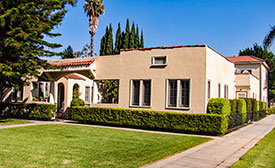
The first bungalow court, designed by Sylvanus Marston, was built in Pasadena in 1909. The style had its roots in either the Spanish patio villa or the summer cabin resort in the woods. The architectural styles of the courts varied widely from Swiss Chalet to Spanish Colonial Revival to Tudor Revival. The typical bungalow court consisted of six to ten small, individual houses placed around a communal garden. Enclosed courts had a structure, often a larger unit, at the end of the open space that created the U-shape. Parking was generally at the rear of the units.
From 1910 to 1930, bungalow courts were the dominant multi-family dwelling type in Southern California. Courtyard housing was a new type of housing that provided both a house and garden for those who could not afford a single-family home or didn't want to be bothered with the upkeep. Unobtrusive bungalow courts blended beautifully within neighborhoods of single-family homes. They offered residents both a sense of community and shared responsibility while allowing for individual space and private gardens.
In Fullerton in the 1920s, the preferred form of multi-housing was the bungalow court. Many transplants from larger cities in the East and Midwest did not want high-density tenement housing in the city and advocated for small house-like apartments, such as the Dunphy Apartments (126 W. Whiting Avenue), or bungalow courts. More bungalow courts were constructed in Fullerton than any other city in Orange County: San Souci Court (501 W. Whiting Avenue), Mariola Apartments (520 E. Commonwealth Avenue), Pomona Court (314 N. Pomona Avenue), Rose Court (125 Ellis Place), and Truslow Court (424 E. Truslow Avenue). Designed by local notable architect Frank Benchley, the Craftsman-style Pomona Court is listed on the national Register of Historic Places.
Unlike apartments, there was no social or economic stigma attached to living in a bungalow court, which represented stability and maintained a semblance of suburban gentility. The courts were easily constructed on a typical single lot and were situated among single-family homes in upper, middle, and even low-income neighborhoods. Truslow Court was constructed specifically to house poorer railroad workers living next to the tracks.
The bungalow courts in Fullerton, which provided six to ten rental units, were laid-out in a U-shape, with a two-story unit at the end of the court serving as a visual focus. All were situated within walking distance of the downtown area to provide quick access to social, economic, and transportation amenities.
After World War II, Fullerton residents still preferred lower density housing, and bungalow courts or bungalow court-influenced apartments were still built. Good examples are the Commonwealth Apartments (605-619 W. Commonwealth Avenue) constructed in 1948, a 16-unit complex composed of four lots, each developed with four apartments, and the Hillcrest Glen Apartments (1100 N. Lemon Street) built in 1962-63.
In the 1960s, an emphasis was placed on building single-family homes in newly developing suburbs. Additionally, more demanding parking requirements no longer made the bungalow court concept a feasible type of residential development on small parcels. When the development of rental housing began in earnest in the mid-1960s, it was designed with larger, boxlike, multi-story buildings that allowed for much higher housing density.
Read More about Bungalow Courts:
-314N.PomonaAvenue.jpg)
Pomona Court (1922)
314 N. Pomona Avenue

Sans Souci Court (1924)
501 W. Whiting Avenue
-125E.EllisPlace.jpg)
Rose Court (1924)
125 E. Ellis Place
-520E.CommonwealthAvenue.jpg)
Mariola Apartments (1929)
520 E. Commonwealth Avenue
-605-619W.CommonwealthAvenue.jpg)
Commonwealth Apartments (1948)
605-619 W. Commonwealth Avenue